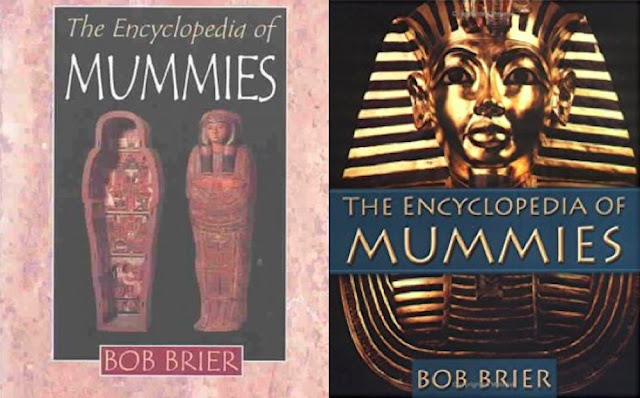Episode 10: The Must-Have for Any Mummyphile Worth Their Weight in Wrappings
Ii-wey! Over the past couple of years, I have been expanding my collection of volumes on mummies for research as well as for leisurely reading. One of the books I have found myself regularly referencing for research purposes, but also pausing to go down a rabbit hole for fascinating insight, is Egyptologist Bob Brier’s The Encyclopedia of Mummies. (Note: I am discussing the 1998 version from Checkmark Books, however there is updated version that was published in 2004 by Sutton Publishing Ltd.)
From a research perspective, there are almost 200 pages of entries that cover individual mummies that have been discovered all around the world, subject matter terms – including scientific ones – that provide a foundational understanding, identifying and describing processes, and popular culture offerings. There are appendices. In the first, Brier provides a list of mummy films commencing with The Mummy of King Ramses (1909, France) through to The Mummy Lives (1993, USA). In the second, Brier provides a detailed list of where various mummy collections are located and a bibliography by subject matter including mummification process, bog mummies and mummy fiction, for example. And, there is an extensive index, which is mandatory.
Here are a few examples of the insightful entries that educate and capture one’s interest:
GROTTAROSSA MUMMY, THE
The only known Roman mummy in existence, this well-preserved eight-year-old girl was found in Rome in the northern district of Grottarossa. (Brier describes the sarcophagus, that she was embalmed not mummified, and the significance of items found with her.)
CEROPLASTY
The art of sculpting anatomical specimens in wax. Because it was difficult during the Renaissance to preserve cadavers for teaching purposes, the practice of crafting specimens became popular. These sculptures were often exquisite works showing the finest anatomical details. Ceroplasty flourished especially in northern Italy, and many of these creations incorporated actual bones as the substructures. (partial entry)
FURTA SACRA
Latin for “stolen relics,” this term often refers to the theft of portions of the miraculously preserved bodies of saints that were stolen during the Middle Ages so other churches could share the glory of having a saint buried within their grounds. Around the year 1200, Hugh, bishop of Lincoln, visited the arm of Mary of Magdalen that was buried in the abbey at Fecamp in Normandy. The arm had been sewn into a protective cloth. Hugh had been refused permission to view the arm, but with a knife he cut open the wrappings. He then tried to break off a few of the fingers so he could return with the relics, but they would not yield. Finally he bit them off with his teeth.
SHRUNKEN HEADS
The preservation of the heads of ancestors, as well as the taking of heads as trophies of war, has been widely practiced throughout the world. Perhaps the most famous of these headhunters were the Jivaro Indians of Ecuador. (Brier goes on to describe the steps for preparing a head for shrinking.)
I WAS A TEENAGE MUMMY
Produced by Ghost Limb Films (1992), this black-and-white low-budget production features Raymond, a demented high school student who has waited centuries to be reunited with Isis, another student who lived in ancient Egypt. The ancient duo take bloody revenge on a gang of toughs who tormented them. Not for those with either a weak stomach or a sense of taste.
In the introduction, Brier explains that he wanted this volume to be as broad as possible, as he sought the encyclopedia to appeal to “the mummy researcher and the lay reader.” He has most assuredly achieved this goal through his choice of entries. This is a great place to start one’s research but can also serve as leisure reading for those generally interested in the subject.
Senebti!



Comments
Post a Comment